Space Housing, Part 2: How We Will Live on the Moon
We talked about space dwellings , it is time to pay attention to the Moon, the nearest object suitable for human settlement.
People have already visited the moon. But the maximum time they spent there was seventy-five hours and one minute. This is not enough, because the space agencies of many countries want to install entire bases on the natural satellite of the Earth that will enable them to perform strategically important tasks, including the needs of the armed forces and the extraction of helium-3.
Scientists have to cope with a variety of problems, including the choice of materials for construction, temperature extremes, the possibility of an autonomous existence of a colony. Next - on the lunar programs in chronological order and on the latest developments that can be used in their implementation.
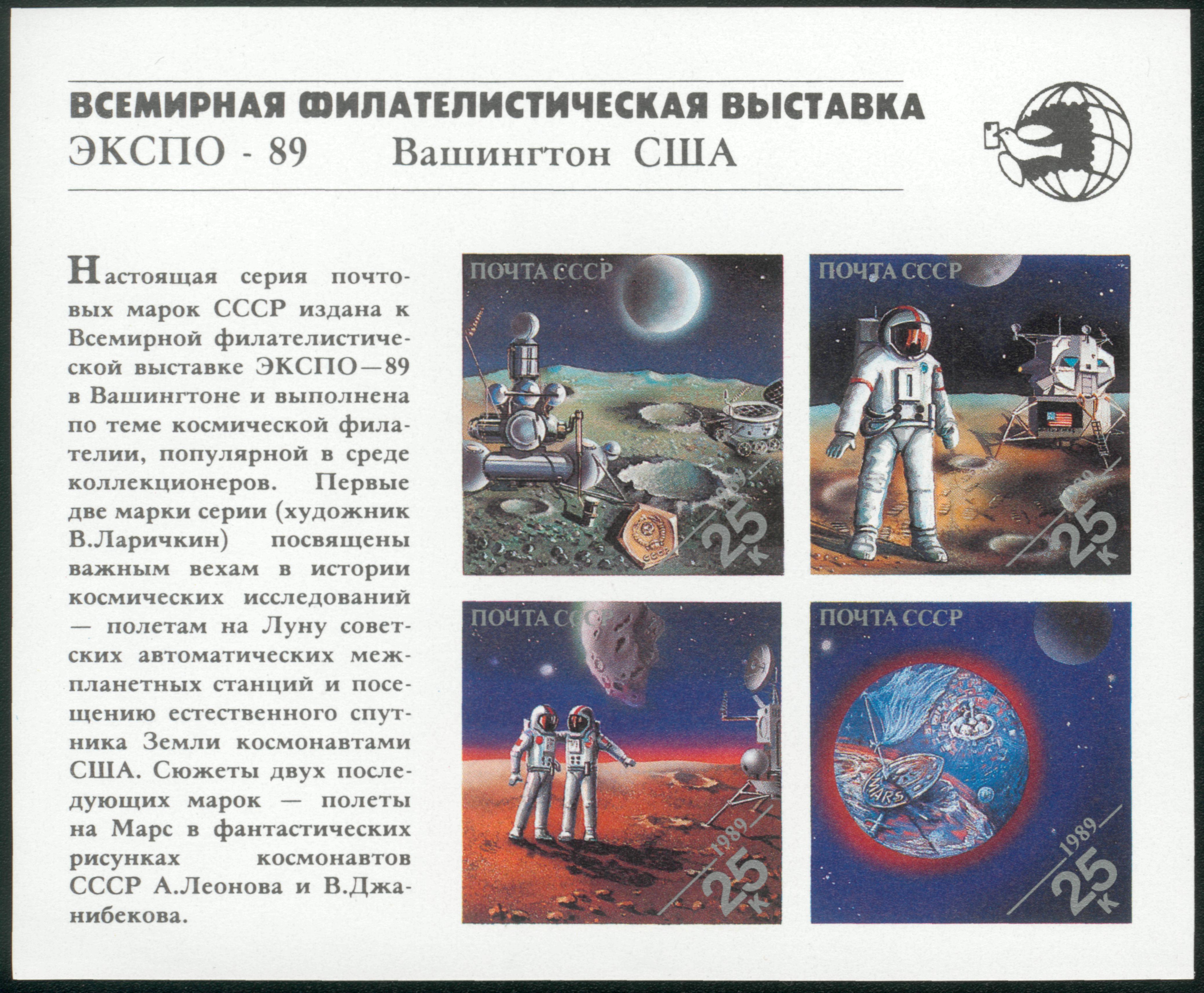
The moon is a natural satellite of the Earth and the second brightest object in the earth's sky. One of the first flights to other space objects in science fiction works began exactly from the moon - in the works of Jules Verne “From Earth to the Moon in Direct Way in 97 Hours and 20 Minutes” and “Around the Moon”. And the Moon was the first extraterrestrial object, which was visited by man .
Work in the direction of colonization in real life began before the 1960s, when the USSR and the USA started the Lunar race.
In the Soviet Union since 1962, Academician Vladimir Barmin and his colleagues from the Spetsmash bureau were responsible for developing the long-term lunar base on behalf of Sergey Korolev. The result was one of the first detailed projects for the exploration of the Moon , the Zvezda .
Within the framework of the project, a group of Soviet scientists needed to think over the goals of the base, the principles of its construction, deployment stages, equipment composition and possible military prospects.
On the moon, planned to place nine habitable modules . For each of them one cosmonaut had to answer. The purpose of the modules is central, command, laboratory-warehouse, workshop, medical with gymnastic simulators, lunch. The remaining three modules are residential.
In 1967, one module was tested on people on Earth at the Institute of Biomedical Problems, after which they decided to equip the premises with a fake window showing images from their home planet. Before the exercise bike decided to put a projector so that the astronaut could "ride around Moscow." According to scientists, these measures turned out to be important for the preservation of the mental health of astronauts.

Typical base module "Star"
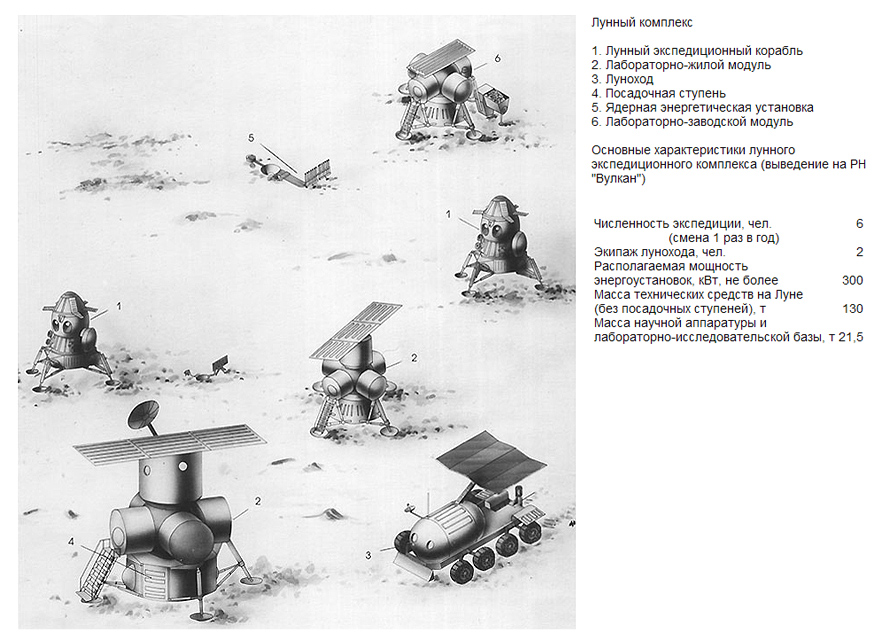
Equipment for the lunar base, the number of expeditions
A little earlier, in 1958, the Americans began developing the Lunex Project, a manned lunar expedition. She supposed to open on Earth’s satellite an underground base of the Air Force for 21 people. The spacecraft on which they planned to deliver astronauts-military to the moon, accommodated three people. They wanted to send the first “party” by 1967, after the manned descent vehicle was created by 1965.
The project had unresolved problems, including the need to develop a lunar launching stage, allowing it to return to orbit and further to Earth.
Placing the base under the surface will allow you to cope with one important problem: temperature differences range from −160 ° C to +120 ° C.
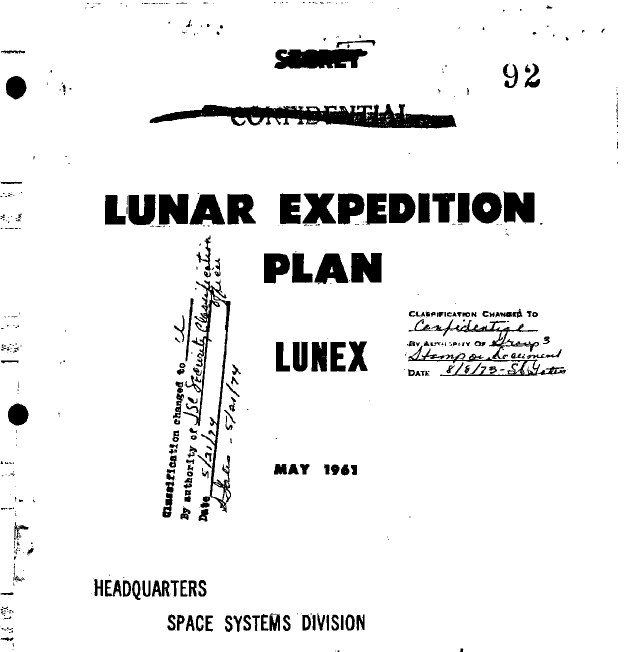
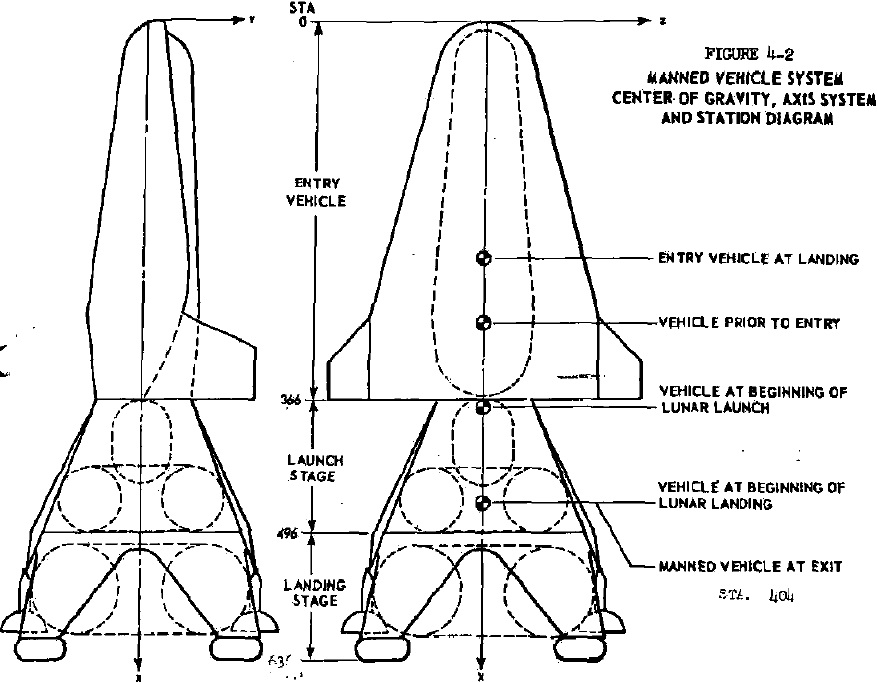
Spaceship Lunex, Wikipedia
At the same time, Project Horizon was being developed. His goal was also to deploy an American military base on the moon. Already in 1966, the base with twelve military had to earn, but the project was never implemented.
The components of the spacecraft and other equipment planned to be delivered to Earth’s orbit for assembly over 147 launch vehicle launches. According to the plan, in 1964 they had to start launches, in January 1965 - to deliver cargo well to the moon. In April 1965, two astronauts were to begin construction of the base. In November 1966, twelve soldiers were supposed to be on the moon. In total, 220 tons of cargo were planned to be delivered to the moon.
Modules for the life and work of the military could be metal cylinders with a diameter of 3.05 meters and a length of 6.1 meters. For power supply planned to use two nuclear power units.
From the Soviet invasion, the bases were planned to be defended using unguided missiles with nuclear warheads and mines modified to puncture the spacesuits.
The project was considered impractical.
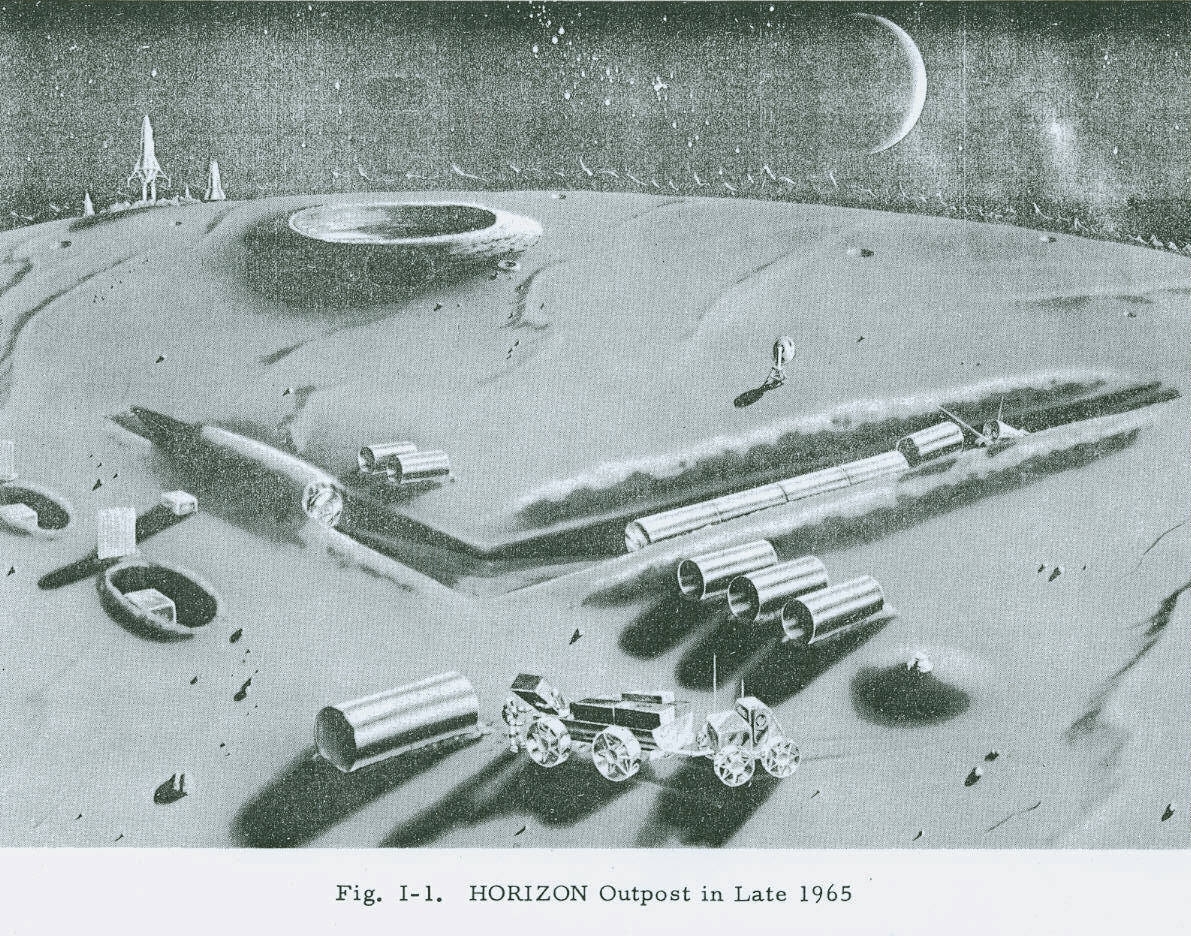
Horizon Lunar Outpost, Source
At the 40th Congress of the International Astronautical Federation in 1989, two NASA staff members, Michael Duke and John Niehoff, presented the Lunar Oasis project , a ten-year program for the colonization of the Moon.
All equipment and people had to deliver over thirty flights, half of which are manned. Each of the manned rockets can deliver up to 14 tons of cargo, unmanned trucks - up to 20 tons. In just ten years, they planned to ship 594 tons of cargo to the moon.
The program consists of three phases, the results of which can be used for various changes. The duration of the first phase is one year. The unmanned truck will deliver a temporary residential module with an autonomous life support system. Four months later, another truck delivers construction equipment, a temporary energy system and food. The third launch will deliver four astronauts to the moon, which will activate the module and begin to deploy the base.
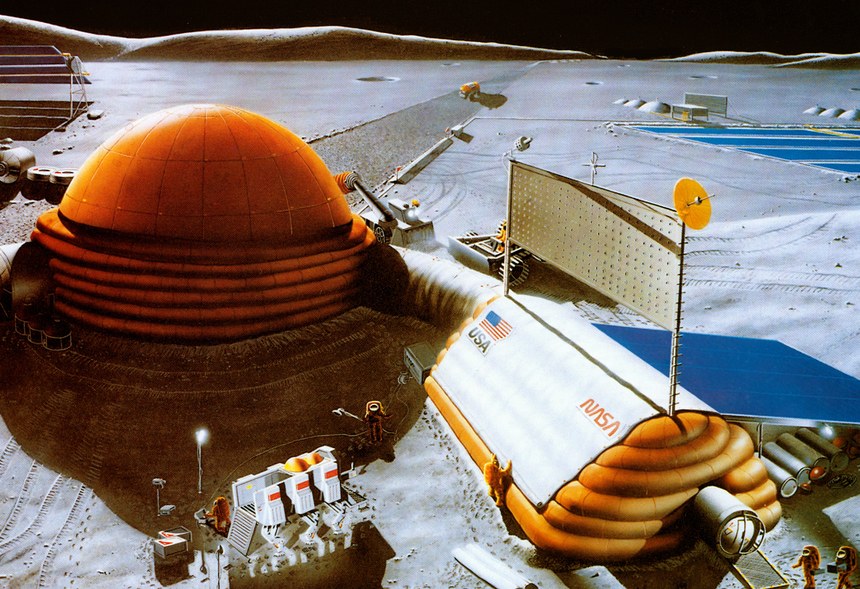
Moonbase Lunar Oasis, 1989, NASA
The fourth cargo ship will deliver food for the next inhabitants of the Moon Oasis, the fifth - a mini-nuclear power plant and equipment for the production of oxygen, carbon dioxide and hydrogen from dust and stones. The sixth mission will deliver six astronauts who will live on the moon for a year.
The final stage of the first phase will open the seventh launch, within which an inflatable dwelling for ten people will be delivered to the moon, which astronauts will assemble and inflate. The module will be placed in the crater to protect from solar and cosmic radiation. As part of the ninth mission, ten astronauts will be delivered to the moon, and six astronauts will return home to Earth.
The walls of the living module can be filled with hydrogen, which can be obtained from the lunar regolith using electrolysis .
The next seven years will take the second and third phases. Another inflatable dwelling, a closed life support system, a megawatt nuclear power plant, production modules, solar batteries and several astronaut expeditions will be delivered to the moon.
The project cost was estimated at 550 billion dollars over ten years, or about 55 billion a year. For comparison: in 2014 alone, the United States spent $ 80 billion on the withdrawal of troops from Afghanistan.
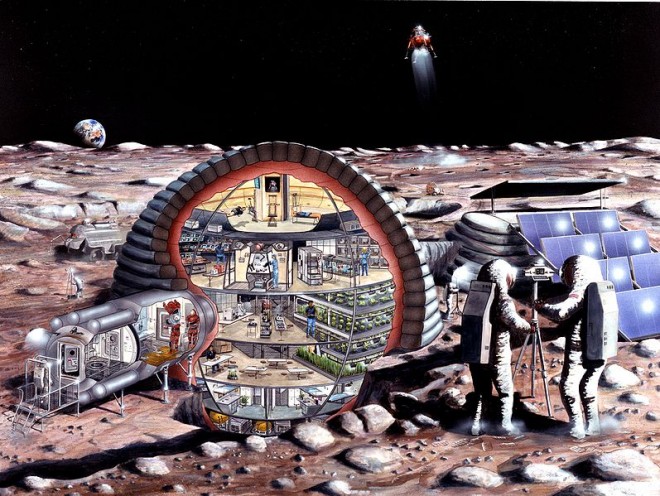
Residential building in section
From 2004 to 2009, the United States developed the “Constellation” program, which involves placing a base on the moon to support flights to Mars. The logo depicts the goals and milestones of the program: the first semicircle symbolizes the Earth - first, the rocket within the program should have reached the International Space Station, the second semicircle - the Moon, the third - Mars. As part of the program, the heavy-duty Ares class of launch vehicles was developed. This is the ancient Greek god of war, to whom in Roman mythology corresponds to Mars.
Barack Obama in 2010 covered the program due to lack of funds. In place of the "Constellation" came a project involving the use of robot avatars.

NASA Constellation Program Logo
Scientists are working on various ways to reduce the amount of cargo required for delivery to the moon. One of these ways - inflatable buildings. They are much lighter than analogs built with the use of a large amount of metal, and at the same time they occupy less space in a disassembled state.
In 2007, experts at the Langley Research Center worked on lightweight inflatable modules that were supposed to be deployed around the landing gear. The modules are made in the shape of a cylinder with a diameter of 3.65 meters, are installed vertically and are equipped with a hermetic lock. Residential compartment tested in Langley.
Such inflatable modules can be temporary housing, and can become permanent, if they are protected from space radiation and meteorite rain with regolith - lunar soil.
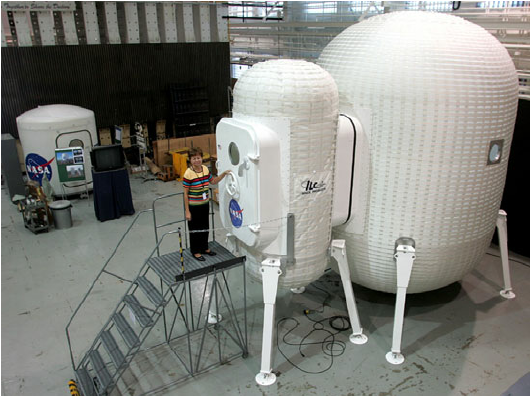
The inflatable module developed by NASA in collaboration with the company ILC Dover
At the same time, there are already modules that are resistant to radiation - these are modules from Bigelow Aerospace . The first modules were sent to space in 2006 and 2007, where they are still located. In April 2016, another module was launched, and on April 16 it was docked to the International Space Station. Over the next two years, astronauts will periodically enter it to test technology, test for the ability to maintain pressure, to withstand radiation, meteorites and space debris. Later, taking into account the test results, they will be able to adapt for deployment on the moon.
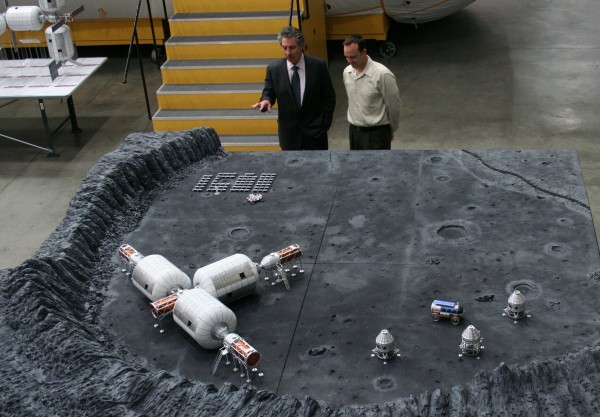
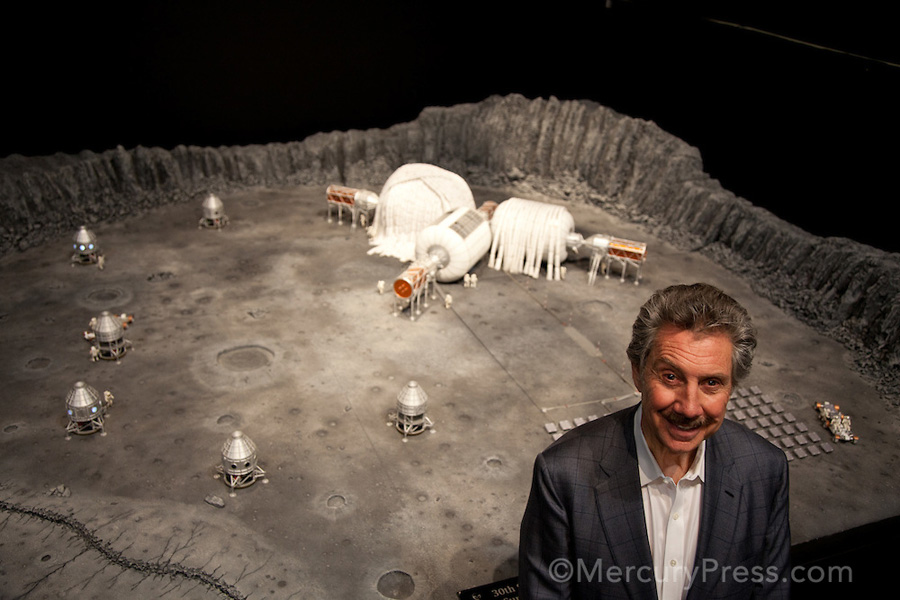
Another option is to build a house right from what is under your feet, using printers. On Earth, homes and offices are already printing , it remains only to modify the design of printers, taking into account the conditions of the moon.
In 2011, the European Space Agency announced a 3D print project for the lunar base , where local soil, regolite, is used as a building material. This loose, various-grained debris-dust layer several meters deep, which consists of igneous rocks, minerals, meteorites, contains aluminum, iron and titanium. Small particles have high adhesiveness. But for printing regolith, it is necessary to add magnesium oxide to it, which will be delivered from the Earth.
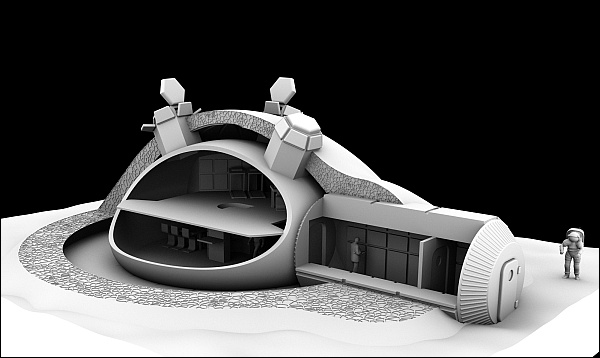
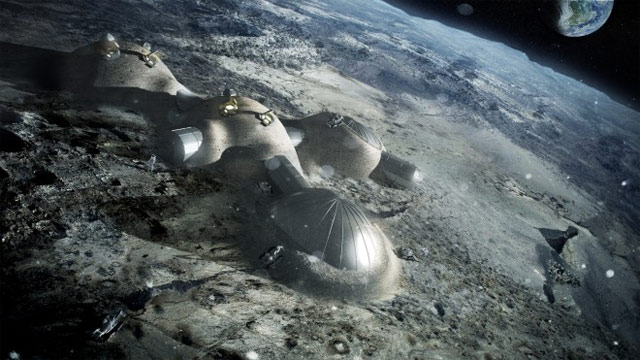
Today, the construction of the lunar base is one of the main strategic goals of the Russian space program for the next decade. The astronauts are planning to send to the moon in the 2030s, while at the same time they plan to build their bases there the US, China, Japan and the European Space Agency. Among the main objectives, it is more often called not the needs of the armed forces, but the extraction of helium-3 , which is necessary for thermonuclear energy. The average price of this isotope per liter in a gaseous state in 2009, according to some estimates, was 930 US dollars.
According to the hypothesis of scientists in the reaction of 1 ton of helium-3 with 0.67 tons of deuterium, the energy released is equivalent to burning 15 million tons of oil. But the miners will have to work tirelessly: only 1 gram of helium-3 falls on 100 tons of regolt, that is, 100 million tons of lunar soil will have to be processed to produce a ton of isotope.
Other goals include conducting experiments in astronomy, cosmology, space biology, studying the cortex to study the evolution of the solar system, and deploy telescopes that are easier to maintain and modernize than space observatories. The base can become a transit point for interplanetary research.
The project of colonization of the moonRoscosmos sent to the Russian government in 2014. At the first stage, an outpost with a power plant, life support module and an experimental laboratory module will be created on the Earth’s satellite. The astronauts will be equipped with moon rovers and lunolets. In 2016, the program was adjusted by scheduling the delivery of astronauts for 2030-2035. When developing the program, scientists actively used developments made in the USSR.
Oleg Saprykin, head of the department of manned programs of the Roscosmos Institute, suggests sending robot avatars to study the surface of the Moon, which, thanks to a delay of just 4 seconds, can be controlled in real time. Roscosmos in robots astronauts from 2016 to 2024 plans to invest 2.5 billion rubles .
For flights to the moon, Roscosmos is planning to use the Federation transport ship . A series of multi-seater ships should replace the "Unions". Development has been conducted since 2009. A ship in autonomous flight can survive for up to 30 days, while a bathroom is provided for astronauts.
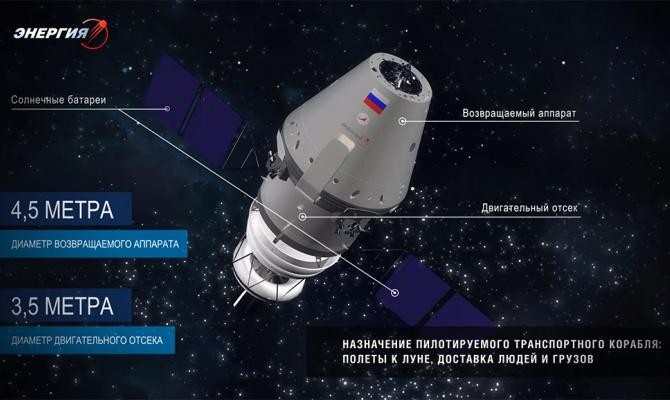
When building a lunar base, scientists need to find a way to protect people from solar radiation and micrometeorites. Unlike the Earth, the atmosphere of the moon does not help. Buildings must be strong enough so that small meteorites can not cause them noticeable damage. The problem of radiation in the case of solar flares is solved by timely shelter in a room that has adequate protection. One of the ways to harden buildings and radiation protection is the use of regolith. Its dust is able to melt in the microwave, turning into glass, this property can be used on the moon for the production of bricks. Regolith can be used for printing buildings using 3D printers, or for embedding modules - inflatable or metal.
Regolith, able to help in construction, is a danger to people. Small particles of lunar dust are dangerous for astronauts, which NASA learned during the Apollo 17 program, when Harrison Schmitt inhaled this dust that got on board the ship along with spacesuits. He began to resemble hay fever , which even an operator in Houston noticed by his voice. Ordinary hay fever, or seasonal allergic rhinoconjunctivitis, is a seasonal disease, the cause of which is an allergy to pollen. In this case, similar symptoms appeared due to moon dust.
Any dust can be harmful, but the body with the help of special villi on the surface of the lungs can bring them to the bronchi, so that a person can then cough and get rid of them. But the villi cannot capture specks of dust up to 2.5 micrometers. Such dust clings to tissues and causes inflammation. In the case of regolith, we are talking about grains of glass and fragments of meteorite iron up to 20 nanometers. They can enter the bloodstream directly.
One of the important tasks for the colonialists is to provide themselves with food. Although compared with Mars to the moon close, it will be better to reduce the amount of cargo that needs to be delivered to the satellite, and accordingly the number of launches. Colonialists will need to repeat the success of Mark Watney and engage in agriculture. Moreover, the water for this on the moon is.
At the moment, several countries have programs for the development of the Earth’s satellite. But, like ten, and thirty years ago, in spite of detailed study and planning, they may not be completed. Judging from the experience of the last fifty years, one of the main problems is financing.
People have already visited the moon. But the maximum time they spent there was seventy-five hours and one minute. This is not enough, because the space agencies of many countries want to install entire bases on the natural satellite of the Earth that will enable them to perform strategically important tasks, including the needs of the armed forces and the extraction of helium-3.
Scientists have to cope with a variety of problems, including the choice of materials for construction, temperature extremes, the possibility of an autonomous existence of a colony. Next - on the lunar programs in chronological order and on the latest developments that can be used in their implementation.

The moon is a natural satellite of the Earth and the second brightest object in the earth's sky. One of the first flights to other space objects in science fiction works began exactly from the moon - in the works of Jules Verne “From Earth to the Moon in Direct Way in 97 Hours and 20 Minutes” and “Around the Moon”. And the Moon was the first extraterrestrial object, which was visited by man .
Work in the direction of colonization in real life began before the 1960s, when the USSR and the USA started the Lunar race.
Star
In the Soviet Union since 1962, Academician Vladimir Barmin and his colleagues from the Spetsmash bureau were responsible for developing the long-term lunar base on behalf of Sergey Korolev. The result was one of the first detailed projects for the exploration of the Moon , the Zvezda .
Within the framework of the project, a group of Soviet scientists needed to think over the goals of the base, the principles of its construction, deployment stages, equipment composition and possible military prospects.
On the moon, planned to place nine habitable modules . For each of them one cosmonaut had to answer. The purpose of the modules is central, command, laboratory-warehouse, workshop, medical with gymnastic simulators, lunch. The remaining three modules are residential.
In 1967, one module was tested on people on Earth at the Institute of Biomedical Problems, after which they decided to equip the premises with a fake window showing images from their home planet. Before the exercise bike decided to put a projector so that the astronaut could "ride around Moscow." According to scientists, these measures turned out to be important for the preservation of the mental health of astronauts.

Typical base module "Star"

Equipment for the lunar base, the number of expeditions
Lunex project
A little earlier, in 1958, the Americans began developing the Lunex Project, a manned lunar expedition. She supposed to open on Earth’s satellite an underground base of the Air Force for 21 people. The spacecraft on which they planned to deliver astronauts-military to the moon, accommodated three people. They wanted to send the first “party” by 1967, after the manned descent vehicle was created by 1965.
The project had unresolved problems, including the need to develop a lunar launching stage, allowing it to return to orbit and further to Earth.
Placing the base under the surface will allow you to cope with one important problem: temperature differences range from −160 ° C to +120 ° C.


Spaceship Lunex, Wikipedia
Project horizon
At the same time, Project Horizon was being developed. His goal was also to deploy an American military base on the moon. Already in 1966, the base with twelve military had to earn, but the project was never implemented.
The components of the spacecraft and other equipment planned to be delivered to Earth’s orbit for assembly over 147 launch vehicle launches. According to the plan, in 1964 they had to start launches, in January 1965 - to deliver cargo well to the moon. In April 1965, two astronauts were to begin construction of the base. In November 1966, twelve soldiers were supposed to be on the moon. In total, 220 tons of cargo were planned to be delivered to the moon.
Modules for the life and work of the military could be metal cylinders with a diameter of 3.05 meters and a length of 6.1 meters. For power supply planned to use two nuclear power units.
From the Soviet invasion, the bases were planned to be defended using unguided missiles with nuclear warheads and mines modified to puncture the spacesuits.
The project was considered impractical.

Horizon Lunar Outpost, Source
Lunar oasis
At the 40th Congress of the International Astronautical Federation in 1989, two NASA staff members, Michael Duke and John Niehoff, presented the Lunar Oasis project , a ten-year program for the colonization of the Moon.
All equipment and people had to deliver over thirty flights, half of which are manned. Each of the manned rockets can deliver up to 14 tons of cargo, unmanned trucks - up to 20 tons. In just ten years, they planned to ship 594 tons of cargo to the moon.
The program consists of three phases, the results of which can be used for various changes. The duration of the first phase is one year. The unmanned truck will deliver a temporary residential module with an autonomous life support system. Four months later, another truck delivers construction equipment, a temporary energy system and food. The third launch will deliver four astronauts to the moon, which will activate the module and begin to deploy the base.

Moonbase Lunar Oasis, 1989, NASA
The fourth cargo ship will deliver food for the next inhabitants of the Moon Oasis, the fifth - a mini-nuclear power plant and equipment for the production of oxygen, carbon dioxide and hydrogen from dust and stones. The sixth mission will deliver six astronauts who will live on the moon for a year.
The final stage of the first phase will open the seventh launch, within which an inflatable dwelling for ten people will be delivered to the moon, which astronauts will assemble and inflate. The module will be placed in the crater to protect from solar and cosmic radiation. As part of the ninth mission, ten astronauts will be delivered to the moon, and six astronauts will return home to Earth.
The walls of the living module can be filled with hydrogen, which can be obtained from the lunar regolith using electrolysis .
The next seven years will take the second and third phases. Another inflatable dwelling, a closed life support system, a megawatt nuclear power plant, production modules, solar batteries and several astronaut expeditions will be delivered to the moon.
The project cost was estimated at 550 billion dollars over ten years, or about 55 billion a year. For comparison: in 2014 alone, the United States spent $ 80 billion on the withdrawal of troops from Afghanistan.

Residential building in section
Constellation
From 2004 to 2009, the United States developed the “Constellation” program, which involves placing a base on the moon to support flights to Mars. The logo depicts the goals and milestones of the program: the first semicircle symbolizes the Earth - first, the rocket within the program should have reached the International Space Station, the second semicircle - the Moon, the third - Mars. As part of the program, the heavy-duty Ares class of launch vehicles was developed. This is the ancient Greek god of war, to whom in Roman mythology corresponds to Mars.
Barack Obama in 2010 covered the program due to lack of funds. In place of the "Constellation" came a project involving the use of robot avatars.

NASA Constellation Program Logo
Inflatable houses
Scientists are working on various ways to reduce the amount of cargo required for delivery to the moon. One of these ways - inflatable buildings. They are much lighter than analogs built with the use of a large amount of metal, and at the same time they occupy less space in a disassembled state.
In 2007, experts at the Langley Research Center worked on lightweight inflatable modules that were supposed to be deployed around the landing gear. The modules are made in the shape of a cylinder with a diameter of 3.65 meters, are installed vertically and are equipped with a hermetic lock. Residential compartment tested in Langley.
Such inflatable modules can be temporary housing, and can become permanent, if they are protected from space radiation and meteorite rain with regolith - lunar soil.

The inflatable module developed by NASA in collaboration with the company ILC Dover
At the same time, there are already modules that are resistant to radiation - these are modules from Bigelow Aerospace . The first modules were sent to space in 2006 and 2007, where they are still located. In April 2016, another module was launched, and on April 16 it was docked to the International Space Station. Over the next two years, astronauts will periodically enter it to test technology, test for the ability to maintain pressure, to withstand radiation, meteorites and space debris. Later, taking into account the test results, they will be able to adapt for deployment on the moon.


Moon Ground Buildings
Another option is to build a house right from what is under your feet, using printers. On Earth, homes and offices are already printing , it remains only to modify the design of printers, taking into account the conditions of the moon.
In 2011, the European Space Agency announced a 3D print project for the lunar base , where local soil, regolite, is used as a building material. This loose, various-grained debris-dust layer several meters deep, which consists of igneous rocks, minerals, meteorites, contains aluminum, iron and titanium. Small particles have high adhesiveness. But for printing regolith, it is necessary to add magnesium oxide to it, which will be delivered from the Earth.


Roscosmos Strategy
Today, the construction of the lunar base is one of the main strategic goals of the Russian space program for the next decade. The astronauts are planning to send to the moon in the 2030s, while at the same time they plan to build their bases there the US, China, Japan and the European Space Agency. Among the main objectives, it is more often called not the needs of the armed forces, but the extraction of helium-3 , which is necessary for thermonuclear energy. The average price of this isotope per liter in a gaseous state in 2009, according to some estimates, was 930 US dollars.
According to the hypothesis of scientists in the reaction of 1 ton of helium-3 with 0.67 tons of deuterium, the energy released is equivalent to burning 15 million tons of oil. But the miners will have to work tirelessly: only 1 gram of helium-3 falls on 100 tons of regolt, that is, 100 million tons of lunar soil will have to be processed to produce a ton of isotope.
Other goals include conducting experiments in astronomy, cosmology, space biology, studying the cortex to study the evolution of the solar system, and deploy telescopes that are easier to maintain and modernize than space observatories. The base can become a transit point for interplanetary research.
The project of colonization of the moonRoscosmos sent to the Russian government in 2014. At the first stage, an outpost with a power plant, life support module and an experimental laboratory module will be created on the Earth’s satellite. The astronauts will be equipped with moon rovers and lunolets. In 2016, the program was adjusted by scheduling the delivery of astronauts for 2030-2035. When developing the program, scientists actively used developments made in the USSR.
Oleg Saprykin, head of the department of manned programs of the Roscosmos Institute, suggests sending robot avatars to study the surface of the Moon, which, thanks to a delay of just 4 seconds, can be controlled in real time. Roscosmos in robots astronauts from 2016 to 2024 plans to invest 2.5 billion rubles .
For flights to the moon, Roscosmos is planning to use the Federation transport ship . A series of multi-seater ships should replace the "Unions". Development has been conducted since 2009. A ship in autonomous flight can survive for up to 30 days, while a bathroom is provided for astronauts.

Perspectives
When building a lunar base, scientists need to find a way to protect people from solar radiation and micrometeorites. Unlike the Earth, the atmosphere of the moon does not help. Buildings must be strong enough so that small meteorites can not cause them noticeable damage. The problem of radiation in the case of solar flares is solved by timely shelter in a room that has adequate protection. One of the ways to harden buildings and radiation protection is the use of regolith. Its dust is able to melt in the microwave, turning into glass, this property can be used on the moon for the production of bricks. Regolith can be used for printing buildings using 3D printers, or for embedding modules - inflatable or metal.
Regolith, able to help in construction, is a danger to people. Small particles of lunar dust are dangerous for astronauts, which NASA learned during the Apollo 17 program, when Harrison Schmitt inhaled this dust that got on board the ship along with spacesuits. He began to resemble hay fever , which even an operator in Houston noticed by his voice. Ordinary hay fever, or seasonal allergic rhinoconjunctivitis, is a seasonal disease, the cause of which is an allergy to pollen. In this case, similar symptoms appeared due to moon dust.
Any dust can be harmful, but the body with the help of special villi on the surface of the lungs can bring them to the bronchi, so that a person can then cough and get rid of them. But the villi cannot capture specks of dust up to 2.5 micrometers. Such dust clings to tissues and causes inflammation. In the case of regolith, we are talking about grains of glass and fragments of meteorite iron up to 20 nanometers. They can enter the bloodstream directly.
One of the important tasks for the colonialists is to provide themselves with food. Although compared with Mars to the moon close, it will be better to reduce the amount of cargo that needs to be delivered to the satellite, and accordingly the number of launches. Colonialists will need to repeat the success of Mark Watney and engage in agriculture. Moreover, the water for this on the moon is.
At the moment, several countries have programs for the development of the Earth’s satellite. But, like ten, and thirty years ago, in spite of detailed study and planning, they may not be completed. Judging from the experience of the last fifty years, one of the main problems is financing.
